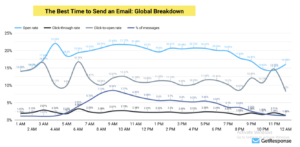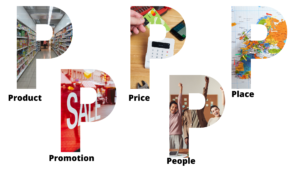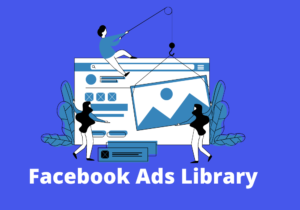Before we dive into the best email marketing practices, lets get to know what email marketing is and why your business needs it.
What is email marketing?
Email marketing is an effective tool for small businesses to acquire, engage, and retain customers. And having a clean email list is essential. As a result, it’s always a good idea to clean up any email list you intend to use before launching a campaign.
Why Email Marketing?
For businesses of all sizes, email marketing is a critical component of their customer acquisition strategies.
However, if you are in charge of maintaining the day-to-day details of your company’s email marketing program, you may feel as if there are too many variables to keep track of in order to get your email program *just right*.
4 Types of Email Marketing Campaigns For Small Businesses
- Acquisition Emails
Acquisition Emails can assist your small business in acquiring customers who have signed up to receive your emails but have not yet converted into customers. By creating appealing offers and informative content, you can demonstrate the value of becoming an active customer to those on your email list. Acquisition emails are an excellent way to move leads through the conversion funnel more quickly, grow your business and drive additional revenue, and target users who have expressed an interest in what your company has to offer.
- Email Newsletters
Email newsletters are one of the most common and popular email marketing campaigns. As a small business, you can use an email newsletter to provide useful information and tools to your subscribers. It is critical to add value to your subscribers’ inboxes by creating engaging content that includes thought leadership, how-tos, and announcements about new services/products. To determine the effectiveness of your newsletter, consider whether the content aids in the development of relationships with subscribers, increases retention and engagement, and strengthens subscriber loyalty.
- Retention Email
Consider Retention Emails for your small business if you have some experience with email marketing campaigns. Your small business can keep the lines of communication open by sending a message requesting feedback or an offer to subscribers who haven’t interacted with your business or email campaigns in a while. Retention emails are a very effective email campaign strategy for keeping your hard-won customers.
- Promotional Emails
Promotional emails are an excellent way for your small business to increase sales, signups, and new product offerings. Promotional emails contain offers that entice and encourage your target audience to purchase a new product or service. Use promotional emails to reward engaged subscribers with exclusive offers, introduce new products or services to your customer base, and cross-sell products to your customer base.
20 best email marketing practices
- Do not buy contact lists.
This first tip should go without saying, but in light of the General Data Protection Regulation (GDPR), it bears repeating.
Email campaigns rely on a healthy open rate, and if you’re contacting people whose information you purchased – rather than earned through a previous interaction – you’ll quickly see your email performance suffer.
The GDPR also requires that you obtain the consent of each European recipient before reaching out to them, and purchased email lists typically do not come with that consent.
Consider reaching out to top talents on Fiverr and Upwork to help you with Lead Generation ads if you need assistance reaching your target audience.
- Remove the noreply@ address.
It’s a little ironic that noreply@ addresses are used. Most marketers will swear that their customers are at the heart of their operations. That they value their customers’ feedback, both positive and negative.
Then, after earning their trust and persuading them to fill out an opt-in form, they use an email address that plainly states:
“We don’t care about you enough to check your inbox.”
I understand. The volume of auto-reply and out-of-office messages can be overwhelming at times. And sometimes your email does not appear to be one that will elicit a response. Your customers, on the other hand, may have a different perspective.
Don’t make it difficult for them to provide feedback. You most likely have business profiles on Twitter, Facebook, and LinkedIn, all in order to be where your customers are. In addition, you must be available.
The same is true for email marketing. Who knows, maybe those who take the time to respond will become your best brand ambassadors.
The advantages of dropping the noreply@ address outweigh the disadvantages.
- Send out greeting emails
The welcome email is the most powerful message you can send.
According to our most recent data, average open rates exceed 80%, while click-through rates range between 22 and 25%.
Welcome emails also aid in the maintenance of your list and the delivery of your emails. If the wrong email address is entered, the welcome email will generate a hard bounce. This then alerts your email provider to remove the email from your list.
They also reassure your new email recipients that their signup was successful and that the information they are looking for is on its way.
They also assist you in connecting with new subscribers. Offer something valuable or exclusive at the start of their journey to increase click-throughs.
- Make sure your email marketing campaigns are well-timed
Every email marketer wants their newsletter to be at the top of the inbox. After all, the majority of subscribers will select the first emails they see.
When should you send your emails, then? It varies according to location, industry, and audience.
The best practice is to use a send-time optimization algorithm, such as GetResponse Perfect Timing, to send your emails. These tools automatically adjust the send time for each individual subscriber based on their previous behavior.
However, if you are unable to use send-time optimization algorithms, you should consider the following results and send your emails early in the morning.
Source: Getresponse
- Follow best practices for email deliverability.
Email deliverability is critical to the success of your campaign. It makes no difference how interesting or beautiful your emails are. Subscribers will not convert if they never see them.
Verifying the email addresses you send to is one way to ensure that your email is read. This is easily accomplished by using an email checker to ensure that the email address exists and is valid.
Many marketers believe that email deliverability is solely the responsibility of their email service provider. But it goes further than that.
Email content, frequency, and list-building strategies all have an impact on deliverability.
- Limit yourself to no more than three typefaces.
The less clutter there is in your email, the more conversions you will receive.
Don’t clog up your email with more than two fonts or typefaces, as this will distract readers and ruin the visual appeal of your email.
Furthermore, you should use web-safe fonts with sizes ranging from 10-point to 12-point. This ensures that your email is readable by all readers and devices.
- Make use of a memorable sender name.
First impressions are important.
In email marketing, it may also be the last one sent. If your email does not stand out and establish trust, your subscribers are unlikely to open it.
And if they ignore your newsletters a few times, your future campaigns may end up in the trash.
That is why paying attention to your sender name is a best practice in email marketing. Consider it your brand name.
It should be well received by your customers. They’ll then look at the subject line and pre-header – or simply open the email.
So, how do you go about doing that?
First and foremost, your sender’s name should be memorable and recognizable.
You must also provide value. Always. This article contains numerous suggestions for doing so, so let’s concentrate on making your sender name identifiable.
The majority of brands use one of the following formats:
– [Brand Name]
– [Employee Name] @ [Brand Name]
– [Brand Name]
– [Brand] Customer Service
– [Brand Name] e-mail newsletter
– [Brand Name] Digest
If you have a strong employee with a strong personal brand who is associated with a specific campaign, you could use the combination of [Employee Name] from [Brand Name].
Abby from GetResponse is a good example.
Topic: A new upcoming webinar
Topic: A new upcoming webinar
However, this may not work for B2B emails where it is more important for the communication to come directly from the brand.
McKinsey
Theme: EMEA Mobile Ecommerce Trends
So take these suggestions, compare them to your brand’s voice guidelines, and A/B test them. Then stick with what works.
People will grow accustomed to seeing the same name over time. If you change it later, they may not immediately associate it with your brand.
You must also consider the sender’s address.
Why?
Because it establishes its own reputation – in the eyes of ISPs – over time.
If you change it too frequently, it may affect whether your recipient’s email provider accepts your emails.
To avoid issues with email deliverability, don’t change it too frequently, send from a company domain (rather than free mail like Gmail or Yahoo), and use a reliable address.
- Keep your mailing list clean on a regular basis.
Even if some of your email contacts do not opt-out of your email campaign, they will never open your emails.
It’s tempting to email as many people as possible in order to reach as many prospects as possible, but keeping your least-engaged recipients on your mailing list can kill your open rate. People who never open emails make your campaign look bad because you’re not comparing the quality of the campaign to your most loyal recipients.
On a regular basis, review your list of subscribers who haven’t engaged with your emails in a certain period of time and remove them. This gives you a more accurate email open rate and keeps people who are no longer interested in hearing from you out of your email campaign.
You can also set up a workflow where they are gradually moved to a less frequent email list based on their activity.
Assume you publish a daily newsletter. You could set up a workflow in which subscribers who do not open your email for two weeks in a row are switched to the weekly email. If those subscribers do not open four consecutive emails, they may be moved to the monthly newsletter. And so forth.
It prevents you from spamming your subscribers with emails they don’t want while also keeping your list clean.
- Keep the main message and CTA above the fold.
The information visible to the reader before they scroll down is referred to as above the fold.
Despite recent research indicating that consumers are scrolling more than they used to due to social media and vertical timelines, above-the-fold content still receives the most attention.
According to Neilsen Norman Group eyetracking research, consumers spend 57 percent of their viewing time on above-the-fold content. This figure drops dramatically to 17% of the second screenful and continues to fall as they scroll.
With this in mind, place your message and CTA above the fold. It will be the first thing your recipients see when they open your email, increasing your conversion rate.
You can also conduct an A/B test to validate the hypothesis and see if it works for your emails.
- Make unsubscribing simple.
One of your primary goals as an email marketer is to expand your email list. And, while you’re spending a lot of time and money to get people to sign up for your emails, you should also be aware that they may unsubscribe at some point.
There could be a variety of reasons for this. For example, they may no longer be able to use your services because they have relocated. Or they have already purchased a comparable product elsewhere. Whatever the reason, it’s pointless to hold a grudge and force people to stay on your list.
By making it difficult to unsubscribe, you run the risk of:
- Best-case scenario: they will ignore your emails or move them to a folder they will never access.
- Worst-case scenario: your emails will be reported as spam.
Both of these outcomes result in poor deliverability and a lower return on investment from your email marketing campaigns.
So, here are a few pointers to help you make your unsubscribe process as simple as possible:
- Don’t make your subscribers log into your app to unsubscribe because they may have lost access to it.
- Explain to your subscribers why they are receiving your emails in the first place, for example, in the footer of your emails or on the unsubscribe page.
- Provide a one- or two-click unsubscribe process via a hyperlink in the footer of your message.
- Use a common phrase as your hyperlink text, such as “Unsubscribe,” so that people can find it quickly in the message.
- Make the unsubscribe link large enough so that people using mobile devices can easily click on it.
- On the unsubscribe page, avoid using dark patterns or tricky copies.
- Make use of lead magnets
Building an email list is more difficult than it used to be due to increased competition. It’s not only difficult because your audience has access to far more information sources.
It’s also because some marketers have abused their access to their subscribers’ inboxes. They’ve sent out far too many irrelevant, uninteresting, or (worse) deceptive email campaigns.
As a result, website visitors may be hesitant to fill out a form and they’ll expect far more in exchange for their email address.
It’s difficult to demonstrate the value of your newsletter in a simple web form. A lead magnet, on the other hand, can be an excellent way to provide value right away.
Lead magnets, also known as incentives, freebies, or ‘bribes,’ are the most effective way to overcome people’s skepticism.
It could be a downloadable ebook, a special industry report, a calendar, or some other enticing freebie.
Here is a comprehensive guide on how to generate leads with lead magnets.
Because there are so many options, you’ll need to test them all to see which one has the highest conversion rate.
- Select meaningful metrics to track and evaluate.
Open rates, click-through rates, click-to-open rates, and so on. Many. Metrics. Take a deep breath; it doesn’t have to be difficult.
To determine which metrics to track, first determine the purpose of your email. As an example:
If you want recipients to read an important update to your terms of service (and the content is directly in your email), create a compelling and urgent subject line and track open rates.
If you want to extend an offer or discount, the main metric to monitor is clicks (and subsequent visits and conversions from your offer).
- Quality trumps frequency (always)
Email marketing can be a powerful tool for digital communication, but increasing your email frequency does not make your message more effective.
In fact, sending too many emails to your recipients will almost certainly have the opposite effect. If recipients are overwhelmed by your communication, they may unsubscribe or, worse, mark your email as spam.
Begin slowly and test how your audience reacts to the frequency with which you send emails.
- Recognize and reward your VIPs
Your most important brand ambassadors are your VIP recipients. Subscribers who consistently open and click (and possibly even share!) your email deserve to be rewarded for their loyalty and engagement. Furthermore, your VIPs can provide you with useful information.
Do you want to try out a new email template or call to action? Starting with your VIP recipients is a good idea. Survey your VIPs to see how you can improve your email program (or to highlight what you’re doing well), and remember to reward them with special offers and discounts. Reward and retain them, and you’ll both benefit.
- Go over your landing pages again.
Designing and writing copy for your email campaigns will take up a significant amount of your time. But think about where you’re sending your recipients as well.
Send your recipients to landing pages that are relevant to your goals and email copy, and that provide a smooth transition. For example, if you want to direct them to a specific product, send them to the product’s landing page rather than your homepage or product line homepage.
- Make it a two-step process.
How do your subscribers end up on your email list? There are several methods for accomplishing this, including single opt-in, double opt-in, and pre-confirmed opt-in, to name a few. We strongly advise you to use a double opt-in method, which requires recipients to not only click a box on your sign-up page but also to click a link in your email to confirm that they meant to do so in the first place.
- Conduct regular communication audits.
Automated email campaigns are frequently marketed as something that can be “set and forget.” That isn’t entirely correct.
What you include in your email communication isn’t always going to be timeless. Your language, the things you’re referring to, or the images you’re using may become not only out of date, but also insulting or opportunistic.
With so much going on in the world around us, we must be cautious about our messaging and how others will perceive it.
So make auditing your automated email communication a habit. Something you do once every quarter or two. This way, you can keep your messaging relevant, engaging, and, most importantly, considerate. Your audience will respect you for it and remain loyal to your brand as a result.
- Create emails that are easy to read.
It’s easy to lose sight of the fact that you have a diverse audience.
Serving them entails more than just segmentation and personalization. You should also ensure that your marketing messages are easily accessible.
Over 2.2 billion people worldwide have some form of visual impairment, according to the World Health Organization.
Most likely, some of your subscribers do as well.
There are ways to make your emails more accessible to them.
To begin, add ALT text to your images. People who use a screen reader will be able to better understand the content.
After the image text, add a period. The screen reader will then pause to allow you to better understand your email.
You can also improve readability by examining the image contrast ratio.
- Plan ahead of time for the holidays.
It’s the happiest–and, sadly, spammiest–time of year. Subscribers are already expecting increased promotion and deals in the run-up to the holiday season, but it’s still important to be mindful and courteous in your sending to avoid overwhelming your users.
During the holiday season, Sendgrid delivery experts recommend modifying your preference centers to include a checkbox that asks your subscribers if they want to opt into holiday email communications. This allows you to properly set expectations with your recipients while also tailoring your holiday email content.
20. Keep up with the most recent email marketing guides and resources.
Email has been around for a long time, but that doesn’t mean it stays the same. Best practices emerge, regulations change, and email marketing strategies come and go. Keeping up with all of the minute changes in email, on the other hand, can be difficult.
That is, if you don’t have a partner like us. We, on the other hand, eat, breathe, and sleep email so you don’t have to. Every year, we publish the most recent and up-to-date email marketing guides and email marketing resources, providing you with the most up-to-date information you need to keep sending stellar campaigns.




